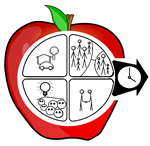Part 4: Model Category: Setting
Part 4: Model Category: Setting - Let's Talk about it!
Max, I'm copying your post to my brother Howard, the "keeper" of the history site. Thanks so much! How would you feel about posting it or some version of it in the appropriate "User Feedback" slot? As for your question, Howard will have an opinion and express it, but my quick reaction (I'm thinking hard about something else right at the moment) is that what's most important is the taking account of and the discussion of "Setting," elevating awareness of it as a factor in the making of sense. I'd probably say to kids, "Categorize it whichever way works best for you," [making it accessible in memory later, if/when exploring relationships between system elements becomes the primary focus]. Give our regards to your kids, and thanks MUCH for the feedback! Marion
Max-- I concur with Marion's opinion, and don't have much to add on the subject. Most categories in classification schemes like our Model tend to have fuzzy edges and overlap here and there, so classifying elements of reality almost always involves some rather arbitrary choices. Virtually all setting elements of "secondary habitat" (e.g. houses, transportation methods, tools, whatever) have their roots in the primary habitat, in use of resources at very least. The main trap we wanted to avoid was the tendency in considering habitat/setting to think only about the natural habitat and forget the (often more influential) secondary, human-made elements of setting. The point is to look at setting as a whole, to become aware of its effects on the actions and thoughts--the culture--of the humans within it. The beauty of it all is that your students are obviously doing some real thinking. Thanks for being willing to use our stuff. Howard

I presented the lesson on Settings---Letters from a Colonial Virginia Planter from INVESTIGATING HISTORY today. I did not follow the entire plan as laid out in your teacher's edition. I incorporated the first two primary sources to have students practice delineating natural elements of setting from human (secondary) elements. The primary sources themselves, letters from a Cavalier named Fitzhugh, lent themselves well with a writing assignment the students were working on. "Talking Heads" is a creative piece of historical fiction in which students take the persona of specific character of an era and write a first person narrative in which the thoughts of the character are shared (in how they are dealing with the situation with which they are involved). A planter, indentured servant, apprentice or slave from a southern colonial plantation of the late seventeenth century were the character options from which students could have chosen. A variety of primary sources, vignettes and video clips (from "Roots") offer students different scenarios in which they can place themselves (their alternative colonial persona) to write the thoughts within "their heads". The actual text of their writing is placed inside the outline of a head whose perimeter covers most of a page of 8 1/2 x 11 sheet of paper. One question about natural and human elements of setting: "Garden", "orchards" "apple trees", "yards", "grounds" were words in one of Fitzhugh's letter. There was legitmate discussion between the students and me concerning whether these words would be placed under the natural or human setting. In the end, I sided with natural since they emanate from the soil. However, since they require an impetus of human action, can one totally discount them from the human element of setting?